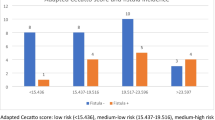Abstract
The etiology of postoperative pharyngocutaneous fistula (PCF) formation following major head and neck surgery is multifactorial and the incidence varies greatly. We reviewed retrospectively the records of 108 consecutive patients who underwent a total laryngectomy during the period from December 1992 to December 2002 at the Helsinki University Central Hospital, Helsinki, Finland. PCF occurred postoperatively in 19 (18%) patients. Two additional patients (2%) developed a PCF later than 30 days after laryngectomy. Nineteen percent of these patients with fistula formation had received previous radiation therapy and laryngectomy was performed for local recurrence. Eighteen (86%) of the all fistulae closed spontaneously and surgical closure of the fistula was performed in three (14%) cases. We conclude that the PCFs in our patient population occurred both in radiated and nonirradiated patients. Although most fistulae close spontaneously without surgical intervention this complication leads to prolonged hospitalization and increased patient morbidity.
Similar content being viewed by others
References
van Bokhorst-de van der Schueren MA, van Leeuwen PAM, Sauerwein HP, Kuik DJ, Snow GB, Quak JJ (1997) Assessment of malnutrition parameters in head and neck cancer and their relation to postoperative complications. Head Neck 19:419–425
Boyce SE, Meyers AD (1989) Oral feeding after total laryngectomy. Head Neck 11:269–273
Dedo DD, Alonso WA, Ogura JH (1975) Incidence, predisposing factors and outcome of pharyngocutaneous fistula complicating head and neck cancer surgery. Ann Otol 84:833–840
Friedman M, Venkatesan TK, Yakovlev A, Lim JW, Tanyeri HM, Caldarelli DD (1999) Early detection and treatment of postoperative pharyngocutaneous fistula. Otolaryngol Head Neck Surg 121:378–380
Ganly I, Patel S, Matsuo J, Singh B,Kraus D, Boyle J, Wong R, Lee N, Pfister DG, Shaha A, Shah J (2004) Postoperative complications of salvage total laryngectomy. Cancer 103:2073–2081
Genden EM, Rinaldo A, Shaha AR, Bradley PJ, Rhys-Evans PH, Ferlito A (2004) Pharyngocutaneous fistula following laryngectomy. Acta Otolaryngol 124:117–120
Hier M, Black MJ, Lafond G (1993) Pharyngocutaneous fistulas after total laryngectomy; incidence, etiology and outcome analysis. J Otolaryngol 22:164–166
Ikiz AÖ, Uça M Güneri EA, Erdağ TK, Sütay S (2000) Pharyngocutaneous fistula and total laryngectomy: possible predisposing factors, with emphasis on pharyngeal myotomy. J Laryngol Otol 114:768–771
Mäkitie A, Irish J, Gullane P (2003) Pharyngocutaneous fistula. Curr Opin Otolaryngol Head Neck Surg 11:78–84
Natvig K, Boysen M, Tausjo J (1993) Fistulae following laryngectomy in patients treated with irradiation. J Laryngol Otol 107:1136–1139
Parikh SR, Irish JC, Curran AJ, Gullane PJ, Brown DH, Rotstein LE (1998) Pharyngocutaneous fistulae in laryngectomy patients; the Toronto Hospital experience. J Otolaryngol 27:136–140
Paydarfar JA, Birkmeyer NJ (2006) Complications in head and neck surgery: a meta-analysis of postlaryngectomy pharyngocutaneous fistula. Arch Otolaryngol Head Neck Surg 132:67–72
Redaelli de Zinis LO, Ferrari L, Tomenzoli D, Premoli G, Parrinello G, Nicolai P (1999) Postlaryngectomy pharyngocutaneous fistula: incidence, predisposing factors, and therapy. Head Neck 21:131–138
Seikaly H, Park P (1995) Gastroesophageal reflux prophylaxis decreases the incidence of pharyngocutaneous fistula after total laryngectomy. Laryngoscope 105:1220–1222
Smith TJ, Burrage KJ, Ganguly P, Kirby S, Drover C (2003) Prevention of postlaryngectomy pharyngocutaneous fistula: the Memorial University experience. J Otolaryngol 32:222–225
Virtaniemi JA, Kumpulainen EJ, Hirvikoski PP, Johansson RT, Kosma VM (2001) The incidence and etiology of postlaryngectomy pharyngocutaneous fistulae. Head Neck 23:29–33
Weingard DN, Spiro RH (1983) Complications after laryngecomy. Am J Surg 146:517–520
Author information
Authors and Affiliations
Corresponding author
Rights and permissions
About this article
Cite this article
Mäkitie, A.A., Niemensivu, R., Hero, M. et al. Pharyngocutaneous fistula following total laryngectomy: a single institution’s 10-year experience. Eur Arch Otorhinolaryngol 263, 1127–1130 (2006). https://doi.org/10.1007/s00405-006-0152-5
Received:
Accepted:
Published:
Issue Date:
DOI: https://doi.org/10.1007/s00405-006-0152-5




